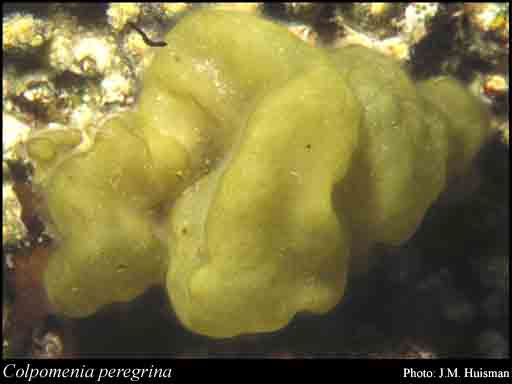- Reference
- Bulletin de la Station Biologique d'Arachon 321 (1927)
- Conservation Code
- Not threatened
- Naturalised Status
- Native to Western Australia
- Name Status
- Current

Scientific Description
Habit and structure. Thallus light to medium brown, sessile with a restricted to broad base, 4–15(–25) cm across and high, globular to broadly lobed or irregularly convolute, membranous, hollow, epilithic or epiphytic. Structure of large inner medullary cells, 2–4 cells thick, and a cortex 1–2 cells thick of small, isodiametric cells (8–)10–16(–18) µm across in surface view, each with a single phaeoplast and pyrenoid; phaeophycean hairs scattered, single or in groups, 6–8 µm in diameter.
Reproduction. Sori spreading over the thallus surface, with scattered hair groups, without an overall cuticular membrane. Plurilocular reproductive organs uni- or occasionally biseriate, 20–40 µm and 5–8 locules long, each row 3–5(–8) µm in diameter, with 2 or 4 rows arising from each cortical cell, accompanied by scattered, clavate, unicellular paraphyses 20–40 µm long and 8–12 µm in diameter. Zooids reproducing the macrothallus directly or from filaments, but functioning as anisogametes (from dioecious thalli) in winter, with the zygotes forming minute discs with erect filaments producing terminal unilocular sporangia.
Distribution. Found generally along southern Australia, from Albany (possibly to the Houtman Abrolhos Is.), W. Aust., to Heron I., Qld and around Tas., usually in the lower eulittoral or upper sublittoral regions.
Habitat. C. peregrina is mainly a lower eulittoral pool or just subtidal alga, but extends to 6 m deep.
[After Womersley, Mar. Benthic Fl. Southern Australia II: 298 (1987)]
Distribution
- IBRA Regions
- Dampierland, Swan Coastal Plain.
- IBRA Subregions
- Perth, Pindanland.
- IMCRA Regions
- Abrolhos Islands, Leeuwin-Naturaliste, WA South Coast.
- Local Government Areas (LGAs)
- Albany, Broome, Cockburn, Greater Geraldton, Mosman Park, Rockingham.